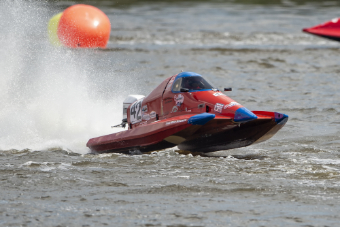Hydrodynamics of Speed on the Water
Surface Piercing Propellers and Fast Boats
Joseph L. McCauley Physics Dept. Univ. of Houston, Houston, Tx. 77204 outboard_services@mccauleyandson.com
Table of contents

1. Streamline flow
- 1.1 Introduction
- 1.2 The Lagrangian description of a flow
- 1.3 The Eulerian description of a flow
- 1.4 Streamlines and vorticity
- 1.5 Bernoulli’s eqn.
- 1.6 Mass conservation and potential flow
- 1.7 The stream function and velocity potential
- 1.8 Sources, sinks and vortices
- 1.9 Circulation conservation
- 1.10 Motion of vortex pairs
- 1.11 Cavitation
- 1.12 Force on an object in streamline flow
- Chapter summary S1.1 Streamline flow, S1.2 Mass conservation, S1.3, Energy conservation, S1.4 Vortices and circulation
2. Shear, vorticity, and drag
- 2.1. Shear, drag and viscosity
- 2.2 The Navier Stokes eqn.
- 2.3 Reynolds nr. scaling
- 2.4 Vorticity and shear
- 2.5 Dimensional analysis of the laminar boundary layer
- 2.6 Skin friction on a flat plate
- 2.7 Boundary layer theory
- 2.8 Form drag, skin friction, and lift
- 2.9 Zhoukowskii’s theorem on lift
- 2.10 Lift and drag coefficients
- 2.11 Vorticity transport and vortex stretching
- 2.12 The laminar wake
- 2.13.Boundary layer separation
- 2.14 Wake behind a cylinder with increasing R
- 2.15 Energy dissipation
- 2.16 Introduction to turbulence
- 2.17 Reynold’s equations and eddy viscosity
- 2.18 The turbulent wake
- 2.19 Dimensional analysis
- 2.20 Turbulence in a pipe boundary layer
- 2.21 Drag on a flat plate
- 2.22 The drag crisis
- 2.23 Eddy viscosity and the mixing length
- Chapter summary S2.1 Viscosity, shear, and drag, S2.2 Reynolds number scaling, S2.3 Skin friction due to a laminar boundary layer, S2.4 Skin friction with a turbulent boundary layer, S2.5 Boundary layer separation and eddy creation, S2.6 Lift and drag coefficients
3. Lifting surfaces
- 3.1 Lift, drag and circulation
- 3.2 The starting vortex, induced drag, and downwash
- 3.3 Lift on a thin wing section
- 3.4 Center of pressure
- 3.5 Camber
- 3.6 Wings in three dimensions
- 3.7 Induced drag
- 3.8 Lift and drag variation with camber and wing shape
- 3.9 Supercavitation
- Chapter summary S3.1 Lift, drag and circulation, S3.2 Lift on a thin wing section, S3.4 Center of pressure, S3.5 Camber, S3.6 Tip vortices and drag, S3.7 Lift and drag on wings, S3.8 Supercavitation
4. Marine propellers and efficiency
- 4.1 Propeller blades are twisted rotating hydrofoils
- 4.2 Full versus partial submersion
- 4.3 Pitch, diameter, and slip
- 4.4 Thrust, torque, power, and mechanical efficiency
- 4.5 Propeller efficiency
- 4.6 Lift and drag on blade sections
- 4.7 Center of pressure
- 4.8. Propeller efficiency and the pitch to diameter ratio
- Chapter summary 4.1S Propeller blades are twisted rotating hydrofoils 4.2S Full vs. partial submersion 4.3S Pitch, diameter and slip
5. Surface piercing propellers
- 5.1 What is surface piercing?
- 5.2 Power-diameter-RPM scaling
- 5.3 Surface piercing propeller efficiencies
- 5.4 Camber, cup, and rake
- 5.4.1 Camber vs. pitch
- 5.4.2 Cup and the blade tip
- 5.4.3 Rake and offset transoms
- 5.5 Circulation conservation, ventilation, and supercavitation
- 5.6 Mathematical design of blade shape, rake, and camber for surface piercing props
- 5.7 History of surface piercing propellers
6. Lift on boats and the speed-power-weight-formul
- 6.1 Introduction
- 6.2 Froude and displacement hulls
- 6.3 Speed-power-weight scaling for planing hulls
- 6.4 Effect of gear ratio
- 6.5 Lift vs. buoyancy during planing
- 6.6 Lift on planing hulls
- 6.7 Lift on a tunnel boat
- 6.8 Camber, center of pressure and stability of a tunnel boat
- 6.9 Ground effect
Link for Shorter Paper on Propeller Theory
Link for Paper on Boat Lift and Plaining
